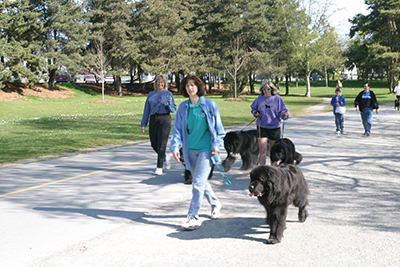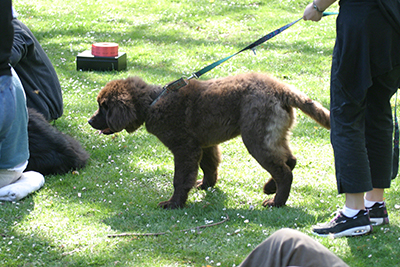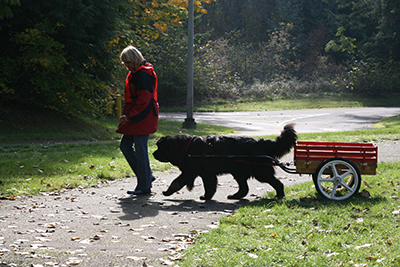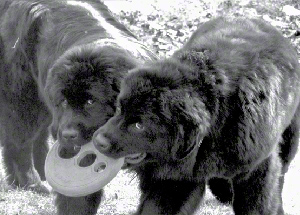
Trips out into the community will be less stressful for you, and more enjoyable for your Newf if they are calm and reliable walking on a leash.
Leashes Are Key
First off, select a collar or harness that is correct for the job. Collars and harnesses for walking are available in a myriad of styles. Not every leash or collar will work equally well for every pup.
Do you have a bold, headstrong puppy? A no-pull harness might work well for you. Is your pup already focused on you and eager to please? You might do well with a flat buckle collar. Have a pup who is a little more timid? Try a limited-slip (martingale) collar, which can be put on somewhat more loosely than a flat collar, but that ensures your pup cannot slip out accidentally by backing up if afraid.
Make Sure the Harness or Collar Fits Right
Be sure the harness or collar fits your pup. Given how quickly Newfoundland puppies grow, this should be a weekly check-up to make sure there are no pressure points or tight areas. Finding an adjustable collar or harness during puppyhood is an ideal solution, and then an adult size can be purchased when your pup hits maturity.
Introduce Your Puppy to the New Collar or Harness

Start by introducing your pup to the collar/harness. Show it to the pup, allowing them to sniff but not to chew or mouth it—you don’t want the puppy to think it is a toy.
Ask your pup to sit and slip the collar/harness over his head, talking and praising as you do so. Repeat, leaving the harness or collar on for a few minutes. If your Newf shows any apprehension, repeat these steps until your pup is calm.
Next, put the collar or harness on fully. Encourage your pup to walk around. If your pup is anxious in the harness or collar, pair it with a familiar positive activity like having dinner.
Consider Introducing the Leash During Play Sessions
Many breeders will begin leash training young pups by allowing them to drag short leashes around during play sessions. This is an excellent approach to socializing pups to what a tug from a leash feels like without negative repercussions.
If your pup did not have this experience, you can replicate it by hooking a one- or two-foot leash to your pup's collar or harness and allowing them to explore and play around the yard while you supervise to make sure they don’t get caught up. When they step on the leash, they will give themselves quick corrections and acclimate to the feeling without any drama. Do not let your pup treat the leash as a chew or tug toy, and discourage any mouthing of the leash. This can cause issues later on.
Take Several Short Walks and Don't Let Your Dog Lead
When you start leash training your dog for walks, remember that your goal should be to have a dog that walks nicely with you without needing any physical restraint. Leashes, collars, and harnesses are tools to get you there. Since young pups cannot go for long walks, use the opportunity for several very short leash-walking sessions over the course of the day, always paired with an upbeat tone of voice and rewards (treats).
If your pup decides to forge ahead and pull, or put on the breaks and tries to backtrack, the best response is to “Be a Tree”—put down some roots and look up to the sky. Stop moving, ignore the behavior, give the pup a moment to collect himself, and then ask for attention and step out again heading in a different direction.
Changing direction makes your pup feel like he needs to pay attention to you in order to know which way you are going.
Begin With Familiar, Low-Distraction Environments
Keep in mind these words from behaviorist Victoria Stilwell:
“Contrary to popular belief, dogs that pull on the leash while being walked do not want to be pack leader, top dog, alpha, or dominant over their human. There is a much simpler explanation: dogs love to be outside, and the walk is a stimulating and exciting part of their day, so the desire to push ahead is very strong.”
As with training for every new activity, start working in a familiar, low-distraction environment (in the house when it is quiet) and slowly add novel locations and distractions. Don’t attempt trips to a busy park on a sunny Saturday until you and your pup are confident with your leash-walking skills. Overwhelming a pup too early or too quickly can lead to fearful or reactive behavior.


